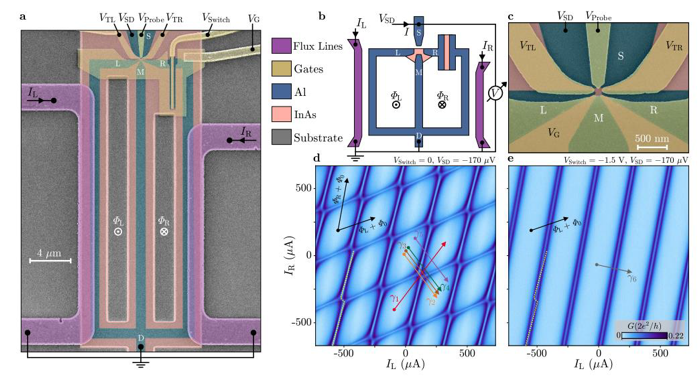Hybridisation of Andreev bound states in three-terminal Josephson junctions
M. Coraiola1, D. Z. Haxell1, D. Sabonis1, H. Weisbrich2, A. E. Svetogorov2, M. Hinderling1, S. C. ten Kate1, E. Cheah3, F. Krizek1,3, R. Schott3, W. Wegscheider3, J. C. Cuevas4, W. Belzig2, and F. Nichele1
1IBM Research Europe—Zurich, 8803 Rüschlikon, Switzerland
2Fachbereich Physik, Universität Konstanz, D-78457 Konstanz, Germany
3Laboratory for Solid State Physics, ETH Zürich, 8093 Zürich, Switzerland
4Departamento de Física Te´orica de la Materia Condensada and Condensed Matter Physics Center (IFIMAC), Universidad Autónoma de Madrid, E-28049 Madrid, Spain
Hybrid Josephson junctions with three or more superconducting terminals coupled to a semiconducting region are expected to exhibit a rich variety of phenomena. Andreev bound states (ABSs) arising in such multiterminal devices have been predicted to form unconventional energy band structures, which can be engineered by controlling superconducting phase differences between the individual terminals. Here we report tunnelling spectroscopy measurements of three-terminal Josephson junctions (3TJJs) realised in a gate-tunable InAs/Al heterostructure. The three terminals are connected to form two loops where phase differences are independently controlled. Our results provide a demonstration of phase control over a novel Andreev band structure. Signatures of hybridisation between ABSs, consistent with their overlap in the 3TJJ region, are observed in the form of avoided crossings in the spectrum and are well explained by a numerical model. Future extensions of this work could focus on addressing spin-resolved energy levels, ground state parity transitions and Weyl bands in multiterminal geometries.
